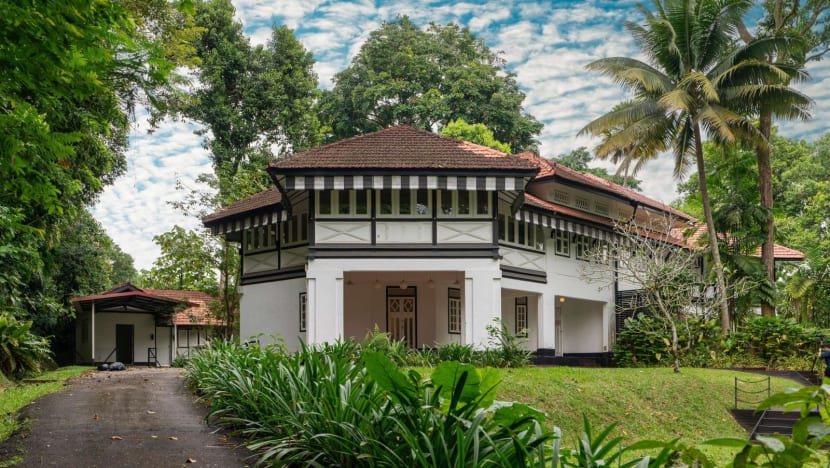SLA studying longer en-bloc leases for estates with black-and-white properties: Edwin Tong
Longer en-bloc leaseholds of 30 or 60 years are being studied to address the limited pool of tenants for black-and-white bungalows, says Second Minister for Law Edwin Tong.

A black-and-white house at 11 Malcolm Road. (Photo: State Property Information Online)
SINGAPORE: The Singapore Land Authority (SLA) is studying the feasibility of extending longer en-bloc leasehold periods, such as 30 or 60 years, in state-owned black-and-white estates for private developers.
This is so that developers can come in as the master leaseholder, rejuvenate the entire estate and reap the benefits over the longer lease period, Second Minister for Law Edwin Tong told parliament on Monday (Jul 3).
Mr Tong was delivering a ministerial statement in the debate on the rentals of 26 and 31 Ridout Road by Law and Home Affairs Minister K Shanmugam and Foreign Affairs Minister Vivian Balakrishnan respectively.
SLA, which rented out the Ridout Road bungalows, is overseen by the Law Ministry, which is helmed by Mr Shanmugam, and Mr Tong, who is also Minister for Culture, Community and Youth.
A report released by the Corrupt Practices Investigation Bureau (CPIB) last week stated that investigations did not find evidence of criminal wrongdoing or preferential treatment given to Mr Shanmugam and Mr Balakrishnan.
A separate review by Senior Minister Teo Chee Hean also found that the two ministers conducted themselves properly in the rental transactions and took appropriate steps to avoid any conflict of interest.
LIMITED POOL OF TENANTS
SLA oversees the management of about 2,600 state properties, including about 600 black-and-white bungalows. Currently, tenancies of black-and-white properties are granted on two-year or three-year terms, up to a maximum of 3+3+3 years in the first instance.
SLA invests a significant amount to upkeep conserved black-and-white properties due to the nature of the conservation requirements, which impose specific restoration guidelines, said Mr Tong.
Tenants also need to be prepared to invest capital to upgrade the properties, while accepting that they can only enjoy the benefits for the length of their tenancy.
"This limits the pool of prospective tenants for black-and-whites," said Mr Tong. To address this challenge, SLA has been adjusting the structure of tenancies to provide more flexibility.
"In suitable cases, where tenants are prepared to commit larger sums of capital expenditure to enhance the properties, SLA has been prepared to grant tenancies of 5+4 years," he said, adding that this gives them more lead time in the initial tenancy to recover their capital expenditure.
"This ties in with the larger goal of maximising occupancy whilst ensuring that tenants are able to keep up and maintain the properties, and where possible, also enhance and add to the property through the tenants' capital expenditure."
Mr Tong said these were among the various measures SLA was taking to "maximise opportunities for the state to benefit from these properties".
RENTAL OF RIDOUT ROAD PROPERTIES
Mr Tong also outlined SLA's policy objectives and process of renting out the black-and-white bungalows, and whether the rentals of 26 and 31 Ridout Road to the two ministers deviated from the usual process.
The bungalows at 26 and 31 Ridout Road, built in the early 1900s, were gazetted as conservation properties in 1992. This status imposes obligations on the property owner, such as respecting the key elements of the properties.
Mr Tong said that a "judicious balance" is necessary between protecting heritage properties and redeveloping them altogether. Some black-and-white bungalows have been repurposed, such as 5 Gallop Road into the Forest Discovery Centre at the Singapore Botanic Gardens' Gallop Extension.
"If the black-and-whites are located amidst or amongst a landed enclave, such as in Ridout Road or perhaps Nassim Road, an area that is zoned for landed properties, removing the black-and-whites or redeveloping them and the land around it would not change the area much," he said.
"The cleared land can only then be similarly used for low intensity development. It would not be possible to put the site to other uses," he said, adding that these include commercial and social uses.
Development plans for black-and-white bungalows are hence driven by master-planning considerations, taking into account each property's specific circumstances such as heritage value, location and possible uses, and being sensitive to the surrounding area, he said.
Turning to the rental process for 26 and 31 Ridout Road, Mr Tong reiterated the findings of the CPIB investigation and Mr Teo's review.
"There was every reasonable, commercial basis for SLA to have entered into those transactions. The terms of both leases were standard and did not contain any unusual clauses. They were entirely at arms-length, and did not deviate from usual processes," he said.
Both properties were managed by the same managing agent - DTZ Facilities & Engineering up to Mar 31, 2018, and Colliers International Consultancy & Valuation from Apr 1, 2018.
SLA and the managing agents had the discretion to decide how to market the properties, and listed only 31 Ridout Road on the State Property Information Online (SPIO) portal.
As the market revived, SLA in August 2022 required all residential state properties available for rent to be listed on SPIO.
The lease for 26 Ridout Road was signed by Mr Shanmugam's wife in June 2018, after the property had been vacant for more than four years. The monthly rent was S$26,500 (US$19,590) with a tenancy of 3+3+3 years.
The lease for 31 Ridout Road was signed by Dr Balakrishnan's wife in October 2019, after having been vacant for more than six years. The monthly rent was S$19,000 with a tenancy of 3+2+2 years.
VALUER DOES NOT KNOW BIDDER'S IDENTITY
Describing the usual valuation process, Mr Tong said the "independent" SLA valuation team will assess the market value of a black-and-white property and give the leasing division a baseline that must be achieved.
"They, meaning the SLA valuation team, do not know the identities of the prospective tenants or the actual rents eventually negotiated by the parties," he said.
Responding to a question by Progress Singapore Party (PSP) Non-Constituency Member of Parliament (NCMP) Hazel Poa, Mr Tong said that SLA knew the identity of the prospective tenant of 26 Ridout Road, as it has to know this to process and assess the tenancy bid.
But the SLA valuation department and SLA valuer who assessed the guide rent did not know the prospective tenant was Mr Shanmugam, he stressed.
"As CPIB has established, the valuer did not even know that Minister Shanmugam and SLA had settled on a rent of S$26,500 per month. She had assessed the guide rent not knowing the identity of the prospective tenant ... or what was the rent he had already agreed to pay," he said.
The valuation was done using an "accepted industry methodology" of direct comparison with the rent of a comparable property, he added.
ADDRESSING OTHER QUESTIONS
Responding to another question by PSP NCMP Leong Mun Wai, Mr Tong said the question of whether the President's agreement is required when not awarding state properties to the highest bidder does not arise in the rental of state properties.
"For state land and state properties, the President's agreement is required if such land or properties are to be disposed of below fair market value such that there would be a draw on past reserves. The grant of tenancies of state properties by SLA is not a disposal of state properties," he said.
Ms Poa and Mr Leon Perera (WP-Aljunied) also asked about trees within the two Ridout Road properties that were felled.
Mr Tong said that both properties are located within the Tree Conservation Area, where any tree measuring more than 1m in girth requires the National Parks Board's (NParks) approval to be felled.
At 26 Ridout Road, after the tenancy started, 19 trees with a girth of more than 1m were felled. Of these, 18 were removed after receiving independent arborist reports and NParks site visits, while one was removed with NParks' approval after failing in bad weather.
Decayed buttress roots, structural defects, termite infestations, poor structural form and vigour, or severe leaning resulting in high potential for failure were found in the felled trees.
At 31 Ridout Road, before the tenancy started, 24 trees with girth of more than 1m were removed with NParks' approval after independent arborist assessment showed they were at risk of failure and posed safety concerns.













.jpg?itok=riat03A-)









